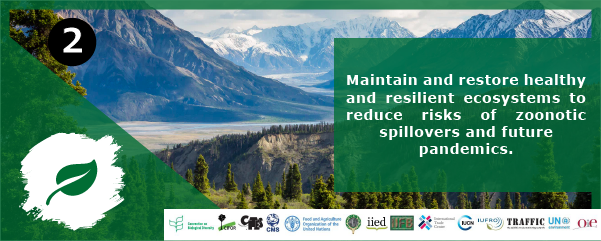„Maintain and restore healthy and resilient ecosystems to reduce risks of zoonotic spillovers and future pandemics.„
The CPW’s second wildlife management principle on COVID-19 related wildlife management challenges addresses ways to prevent future zoonotic disease spillovers and pandemics.
The path to a healthy and sustainable future can only be achieved by maintaining and restoring healthy ecosystems.
In doing so, it is important to first consider that humans are very much a part of global ecosystems, with policy responses then created with this in mind.
Therefore, not only is it essential that human activities are factored into ecosystem management, but it is equally important to attempt to mitigate our own impact on the natural world.
The CPW statement states that the encroachment of human activities into ecosystems, and the subsequent destruction of ecosystems, increases the risk of emergence and spread of zoonotic diseases.
In particular, the following activities bring about the most risks from a zoonotic disease perspective:
- Deforestation
- Habitat degradation and fragmentation
- The unsustainable expansion of agriculture
One tool that can be used to support ecosystems is the sustainable utilisation of wildlife resources. This gives value to wildlife, while also supporting people and communities living in wildlife areas.
In turn, regulated, sustainable hunting programs are able to secure these spaces as wild areas, thereby conserving species and habitats. Furthermore, this has the added benefit of preventing more destructive forms of land usage, such as agriculture (and its associated destruction of habitats) from being introduced in such areas.
The Savé Valley Conservancy (SVC) in Zimbabwe is one case study that demonstrates the conservation benefits of hunting initiatives. The conservancy, which covers an area of 344,000 ha, was originally used for livestock ranching, which decimated wildlife populations in the area.
Private land owners then shifted to a wildlife utilisation model after deciding that livestock was no longer sustainable for the surrounding ecosystem. This resulted in an increase in overall biodiversity and the regeneration of populations for many species, with the conservancy now hosting some 1,500 African Elephants, 121 Black Rhinos and 42 White Rhinos, 280 Lions and several packs of the endangered African Wild Dog.
The SVC is globally recognised as an example of best practice when it comes to sustainable use, with the conservancy even being awarded the CIC Markhor Award in 2016, in recognition of its outstanding efforts in conservation, linking biodiversity and livelihoods to sustainable use.
It is examples like this, where we look to limit our own impact on ecosystems while building and maintaining their resilience, that will allow us to improve ecosystem health, of which humans are an inevitable part, and reduce the risk of future pandemics.

